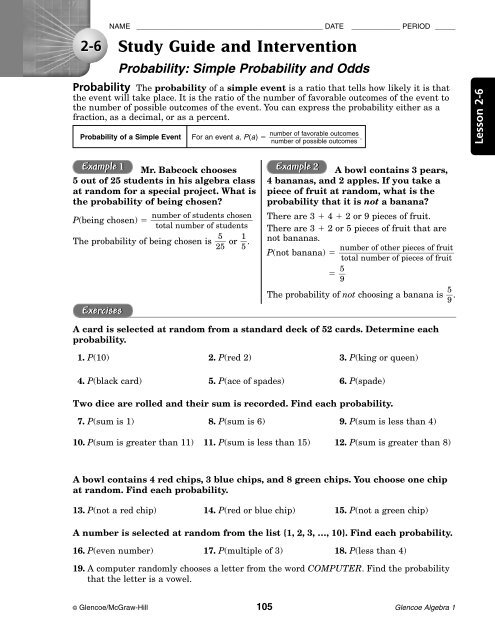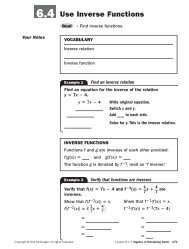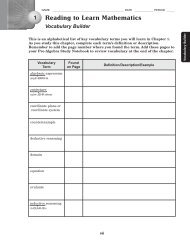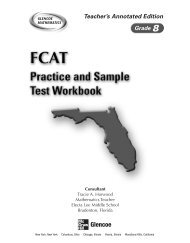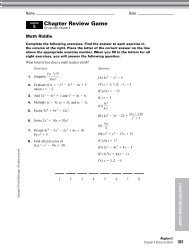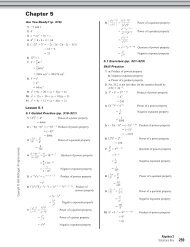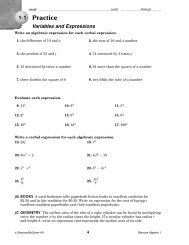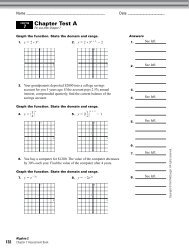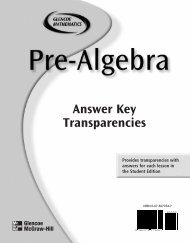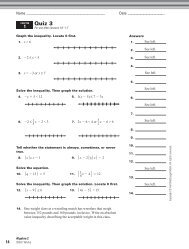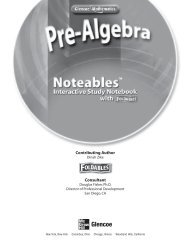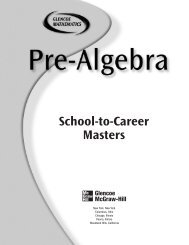Study Guide and Intervention (continued) - MathnMind
Study Guide and Intervention (continued) - MathnMind
Study Guide and Intervention (continued) - MathnMind
You also want an ePaper? Increase the reach of your titles
YUMPU automatically turns print PDFs into web optimized ePapers that Google loves.
2-6<br />
NAME ______________________________________________ DATE ____________ PERIOD _____<br />
<strong>Study</strong> <strong>Guide</strong> <strong>and</strong> <strong>Intervention</strong><br />
Probability: Simple Probability <strong>and</strong> Odds<br />
Probability The probability of a simple event is a ratio that tells how likely it is that<br />
the event will take place. It is the ratio of the number of favorable outcomes of the event to<br />
the number of possible outcomes of the event. You can express the probability either as a<br />
fraction, as a decimal, or as a percent.<br />
number of favorable outcomes<br />
Probability of a Simple Event For an event a, P(a) .<br />
number of possible outcomes<br />
Mr. Babcock chooses<br />
5 out of 25 students in his algebra class<br />
at r<strong>and</strong>om for a special project. What is<br />
the probability of being chosen?<br />
P(being chosen) <br />
The probability of being chosen is or .<br />
1<br />
A bowl contains 3 pears,<br />
4 bananas, <strong>and</strong> 2 apples. If you take a<br />
piece of fruit at r<strong>and</strong>om, what is the<br />
probability that it is not a banana?<br />
number of students chosen<br />
<br />
total number of students<br />
5<br />
<br />
25 5<br />
There are 3 4 2 or 9 pieces of fruit.<br />
There are 3 2 or 5 pieces of fruit that are<br />
not bananas.<br />
P(not banana) <br />
<br />
The probability of not choosing a banana is .<br />
5<br />
Example 1 Example 2<br />
number of other pieces of fruit<br />
<br />
total number of pieces of fruit<br />
5<br />
<br />
9<br />
<br />
9<br />
Exercises<br />
A card is selected at r<strong>and</strong>om from a st<strong>and</strong>ard deck of 52 cards. Determine each<br />
probability.<br />
1. P(10) 2. P(red 2) 3. P(king or queen)<br />
4. P(black card) 5. P(ace of spades) 6. P(spade)<br />
Two dice are rolled <strong>and</strong> their sum is recorded. Find each probability.<br />
7. P(sum is 1) 8. P(sum is 6) 9. P(sum is less than 4)<br />
10. P(sum is greater than 11) 11. P(sum is less than 15) 12. P(sum is greater than 8)<br />
A bowl contains 4 red chips, 3 blue chips, <strong>and</strong> 8 green chips. You choose one chip<br />
at r<strong>and</strong>om. Find each probability.<br />
13. P(not a red chip) 14. P(red or blue chip) 15. P(not a green chip)<br />
A number is selected at r<strong>and</strong>om from the list {1, 2, 3, …, 10}. Find each probability.<br />
16. P(even number) 17. P(multiple of 3) 18. P(less than 4)<br />
19. A computer r<strong>and</strong>omly chooses a letter from the word COMPUTER. Find the probability<br />
that the letter is a vowel.<br />
© Glencoe/McGraw-Hill 105 Glencoe Algebra 1<br />
Lesson 2-6


